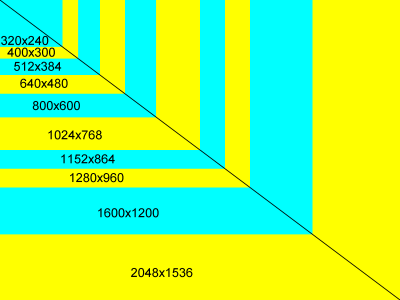tft flatpanel aspect ratio
everything is stretched.
square pixels
A square pixel is a pixel with the same width and height - as opposed to a rectanglular pixel which has a different height and width. a graphics mode for a (windows, linux, etc) desktop should be square pixels.
the 4:3 aspect ratio
The 4:3 aspect ratio for displays and display modes/resolutions is extremely common and can't be ignored.
Almost all PC graphics modes and many video (avi, etc) resolutions are 4:3 with square pixels
Examples: 320x240, 400x300, 512x384, 640x480, 800x600, 1024x768, 1280x960, 1600x1200, 2048x1536.
This is also why you sometimes see a game supporting 1280x960, but not 1280x1024 (example: battlefield 2).
You can verify a mode is 4:3 by dividing the the width by 4, and then multiplying it with 3. Then you get the height.

TV uses 4:3 aspect ratio
For widescreen, it uses 16:9 aspect ratio. Resolutions typically used by DVD's and digital video have non square pixels.
PC CRT monitors are almost always 4:3 aspect ratio
the 1280x1024 mode
Traditionally, the video mode with a width of 1280 pixels has been 1280x1024 - it is what everything supported first. 1280x960 came later. i dont know the origin of the 1280x1024 video mode but it must be something legacy, probably some proffesional workstation in the '80s.
If one uses square pixels, the aspect ratio is 5:4, which is a bit higher than 4:3.
tft flatpanels
Flatpanels exist in various resolutions/sizes. Common are the following:
- 1024x768 (4:3, 17" and smaller)
- 1280x1024 (5:4, 17", 19")
- 1600x1200 (4:3, 20" and bigger)
- widescreen (16:10)
There is little use for a flatpanel to be 1280x960, because it would be unable to show the popular 1280x1024 mode natively. So they don't exist afaik. My favorite display mode is 1280x960.
I use a CRT monitor for various (other) reasons. Getting (approximately) this resolution on a tft means having to get 1280x1024 and 5:4 aspect. There are 3 ways in which a tft panel could show a mode of another resolution/aspect ratio:

- Each pixel from the mode is 1 pixel on the tft ("1 on 1")
- Stretch to the size of the tft while maintaining aspect ratio, use borders if needed ("letterbox")
- Stretch to the size of the panel, without maintaining aspect ratio, everything becomes a bit too tall.
In reality, tft panels always support and default to way #3, sometimes support way #1, but i have never seen support for #2. This means that if you show any mode other than 1280x1024 on a tft panel, for whatever reason (for example software which doesnt support it, or lower resolutions in games for performance reasons), everything is slightly too tall, pixels are not square. I think this is sad, considering geometry on a tft is inherently exact, and this option could easily be added.
solution
1: Makers of tft flatpanels could add an option to support stretching to full size while maintaining aspect ratio.
2: Since video drivers are supporting 3d rendering/effects for desktops etc already, its probably easy for a modern 3d videocard + drivers to output a 1280x1024 mode, while stretching other video modes to fit in it, and this would be configurable in the video drivers, so this kind of feature is possible. also one would no longer have the problem of manually adjusting every single mode to show correctly in the monitor.
ati catalyst drivers support this for digital out, but only support above mentioned modes #1 and #3. they could add mode #2:

back to main page


